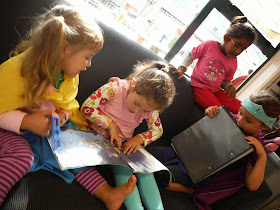The book
titled ‘Room on the Broom’ written by Julia Donaldson and illustrated by Axel
Scheffler, would be one of our children’s most favourite and frequently requested.
At the end of last term I was working
with a group of children, and I thought I would share their learning with you.
Room on the
Broom is truly a special story that seems to really capture children’s
attention from the first page to the last; as well as foster their curiosity, excite
their imaginations and spark a full spectrum of feelings from joyful, sadness,
and even slightly scared. It is one of
those books that children seem to absolutely love to listen to, and explore the
story over again and again. It’s
wonderful how some of the children fully immerse themselves into taking roles
of the characters and complete the sentences from the book.
“Adults should read and tell stories,
provide books, and use story times to allow children to exchange and extend
ideas, reinforcing developing concepts of, and language for, shape, space, size
and colour as well as imaginative responses.”
Te Whāriki p.73
One of our
children explained how they had a DVD of Room on the Broom at home, so they
brought it along to share with the other children who were interested to watch. It was fascinating to observe the children’s
reactions as they watched the story come to life in animation on the big
screen. Afterwards they were keen to
share what they most enjoyed and remember about the story; Emma said “The best part of the story is the monster
it says, ‘buzz off that’s my witch’ to the dragon and then the dragon gets a
fright then let’s go of the witch, then flies far, far, far away.” Peter said “I love the dragon and he has fire coming out.” Kayla said “I like the witch flying on her broom stick. I’m not scared of the monster or dragon; I’m
not scared of anything.”
While discussing
with the children what their favourite parts of the story were, my attention
was drawn to the children’s attention. I
could clearly see they were enthralled with the ending of the book where it
reads “Iggety, ziggety, zaggety,
ZOOM! Then out rose… a truly magnificent
broom”. This part of the story
seemed to really captivate the children, which subsequently led them to design
their own magical brooms sticks. I love
how a story like Room on the Broom provokes imagination and creativity amongst
our children.
“The imagination is energetically
deployed and reaches its peak in children’s early years of life; however, it
gradually declines as children grow older.
But, imagination is precisely what is needed to keep us intellectually
flexible and creative in modern societies.” Wright,
2010
Here are some
examples of the children’s work;
Miller: “Mine is a superhero broom. The black bit is the thing that makes it go
really fast. This is the wing so it can
fly. I’m going to do dots; these are
going to scare away the meanest dragon of all.
This is the light so they can see at night time. I have giant seats and a roof so they don’t
get wet. This is a rope so they can
rescue people if they have to. Here is
the superhero window. This red button is
to make it go super fast.”
Mia: “That’s
the witch, that’s the dog Zippy, that’s my cat Bingy and that’s my bird. This is nice and round so the bird doesn’t
touch the roof. The bird is so tall on
this perch. These fairy lights sparkle
in the night, only at night. They don’t
sparkle at the day time cause it will make the batteries ran flat. The roof is so they don’t get wet and they
will always have a home. You’re not
allowed to touch in there or you will get fire on your hands.”
Tyler: “This
seat is for the witch, this one for the cat, this one for the dog, this one for
the bird, and this one will be for the frog.
That is for the petrol so it will go.
These are magic flowers that magic the broom to go.”
Reese: “One
seat for the bird and a shower for the frog.
That’s a door for a special place to put stuff in. I’m making a bus broom, so it can fly and
have wheels.”
Emma: “This
is my broom stick, here is my purple chair and I have a light at the front and
light at the back so I can see. I’m
going to put on a roof on mine. My broom
stick can be a boat, submarine or bus.
This me on my chair, I’m going to have a pet mouse, this is going to be
its chair. Now I need a blanket for the
mouse. I’m going to draw a dog and this
is its chair. I got a roof so nobody
gets wet from the rain. This is my frog. This is my bowl of strawberries so I can eat
them. I need a magic wand and heaps of
little lights with a little house for the fairies. I’m drawing heaps of wings to help it fly.”
Taika: “That’s me and that’s Noah and Mummy and my
Dad. It has a steering wheel to drive
and it has lights.”
“Imagination is more
important than knowledge. For knowledge
is limited to all we now know and understand, while imagination embraces the
entire world, and all there ever will be to know and understand.” Albert
Einstein
Ngā mihi nui
Susie
Susie
















.JPG)











